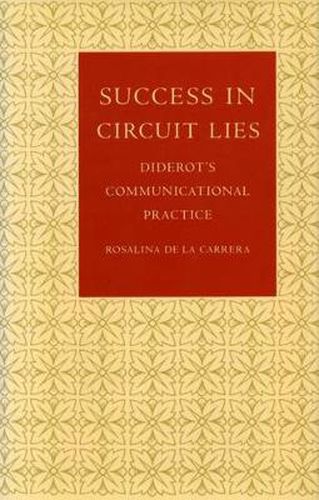Readings Newsletter
Become a Readings Member to make your shopping experience even easier.
Sign in or sign up for free!
You’re not far away from qualifying for FREE standard shipping within Australia
You’ve qualified for FREE standard shipping within Australia
The cart is loading…






As contemporary thinkers continue to explore the intellectual affinities that bind the eighteenth and twentieth centuries, their attention has turned with increasing frequency to Diderot. Focusing on models of communication, this book draws on an interdisciplinary configuration - a conjunction of communication theory, philosophy of science, and literary theory - to analyze texts from Diderot’s own interdisciplinary corpus.
Of particular pertinence to the author’s argument is Michel Serres’s model of dialogue. Rejecting the traditional notion of dialogue as a binary exchange, Serres defines it instead as the product of the association of two interlocutors, who join forces against a third term - another interlocutor or background noise - that threatens to disrupt the exchange. Serres thus substitutes a ternary model of dialogue for the conventional binary one.
Using Serres’s model as a point of departure, the author not only identifies specific instances of Diderot’s use of a ternary communicational model but, more important, also demonstrates how Diderot’s writings themselves generate a ternary model of communication that is uniquely his.
She does this by tracing the model through texts drawn from domains as diverse as fiction, history, and natural philosophy. The repeated recurrence of Diderot’s ternary model in these different contexts brings into focus an unexpected unity in what at first looks like a disparate corpus. As the analysis proceeds, furthermore, it also becomes clear that Diderot’s materialist philosophy dictates a rhetoric aiming at the sensitive body just as much as the reasoning mind.
Though the astounding diversity of Diderot’s writings - as encyclopedist, novelist, playwright, philosopher, scientific theorist, and art critic - has most often led critics to avoid the question of what coherences there might be within that diversity, in this book the author asks just that question - and goes far toward providing a convincing, satisfying, and stimulating answer.
The book includes a new translation of the Preface-annexe of La Religieuse, the integral part of Diderot’s novel missing from most readily available English-language editions.
$9.00 standard shipping within Australia
FREE standard shipping within Australia for orders over $100.00
Express & International shipping calculated at checkout
As contemporary thinkers continue to explore the intellectual affinities that bind the eighteenth and twentieth centuries, their attention has turned with increasing frequency to Diderot. Focusing on models of communication, this book draws on an interdisciplinary configuration - a conjunction of communication theory, philosophy of science, and literary theory - to analyze texts from Diderot’s own interdisciplinary corpus.
Of particular pertinence to the author’s argument is Michel Serres’s model of dialogue. Rejecting the traditional notion of dialogue as a binary exchange, Serres defines it instead as the product of the association of two interlocutors, who join forces against a third term - another interlocutor or background noise - that threatens to disrupt the exchange. Serres thus substitutes a ternary model of dialogue for the conventional binary one.
Using Serres’s model as a point of departure, the author not only identifies specific instances of Diderot’s use of a ternary communicational model but, more important, also demonstrates how Diderot’s writings themselves generate a ternary model of communication that is uniquely his.
She does this by tracing the model through texts drawn from domains as diverse as fiction, history, and natural philosophy. The repeated recurrence of Diderot’s ternary model in these different contexts brings into focus an unexpected unity in what at first looks like a disparate corpus. As the analysis proceeds, furthermore, it also becomes clear that Diderot’s materialist philosophy dictates a rhetoric aiming at the sensitive body just as much as the reasoning mind.
Though the astounding diversity of Diderot’s writings - as encyclopedist, novelist, playwright, philosopher, scientific theorist, and art critic - has most often led critics to avoid the question of what coherences there might be within that diversity, in this book the author asks just that question - and goes far toward providing a convincing, satisfying, and stimulating answer.
The book includes a new translation of the Preface-annexe of La Religieuse, the integral part of Diderot’s novel missing from most readily available English-language editions.